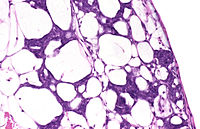
Photo from wikipedia
Simple Summary We have studied the effect of two glucocorticoid hormones: hydrocortisone and its synthetic analogue methylprednisolone on regeneration activity of Girardia tigrina planarian tissues. The results indicate that both… Click to show full abstract
Simple Summary We have studied the effect of two glucocorticoid hormones: hydrocortisone and its synthetic analogue methylprednisolone on regeneration activity of Girardia tigrina planarian tissues. The results indicate that both hormones influence the recovery rate of the regenerating tissue in either a stimulatory or inhibitory way depending on the hormone, its concentration and the regenerating body part of the worm. We suggest that exogenous glucocorticoids can influence endogenous mechanisms of endocrine regeneration, including hormone-receptor interaction. The revealed features of the effects of hydrocortisone and methylprednisolone may be associated with the formation of specific hormone–receptor complexes with each of them, as well as with the dependence of the effects of methylprednisolone on the type of interaction with hydrocortisone receptors i.e., as an agonist or as an antagonist. Abstract We have studied the effect of two glucocorticoid hormones: hydrocortisone and its synthetic analogue methylprednisolone on the regeneration activity of head and tail blastema of the Girardia tigrina planarian. The regeneration activity was studied in head and tail blastema formed after resection by means of lifetime computer morphometry and immunohistochemical labeling of neoblasts. The search for orthologous proteins—glucocorticoid receptors (hydrocortisone) was performed using the SmedGD database of the Schmidtea mediterranea planarian. The results indicate that both hormones influence the recovery rate of the regenerating head and tail blastema. The worms with regenerating tail blastema have less sensitivity to the hormones’ treatment compared to the ones with regenerating head blastema. Hydrocortisone at a high concentration (10−3 M) suppressed the regeneration rate, while stimulating it at lower concentrations (10−4–10−6 M). The same concentrations of methylprednisolone inhibited the regeneration of head blastema, but did not affect the tail blastema regeneration. The two hormones acted differently: while hydrocortisone stimulated the proliferation of neoblasts in the periwound region, methylprednisolone reduced the mitotic activity, mainly on the tail zone furthest from the wound surface. We suggest that exogenous glucocorticoids can influence endogenous mechanisms of hormone-dependent regeneration.
Journal Title: Biology
Year Published: 2023
Link to full text (if available)
Share on Social Media: Sign Up to like & get
recommendations!